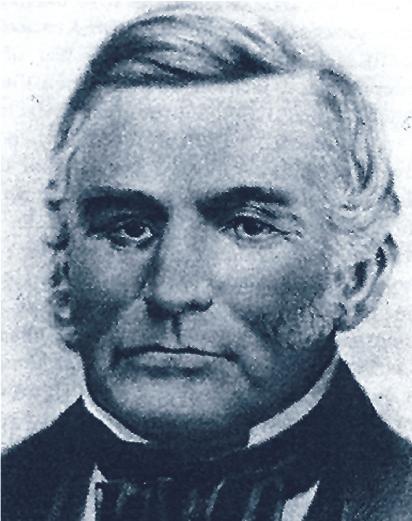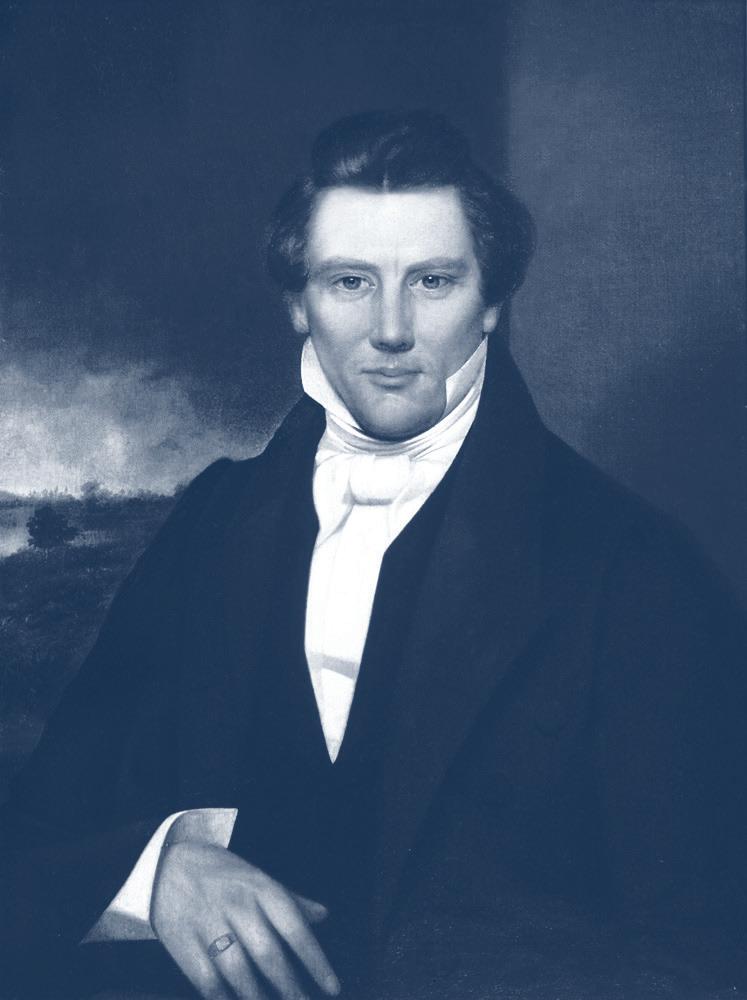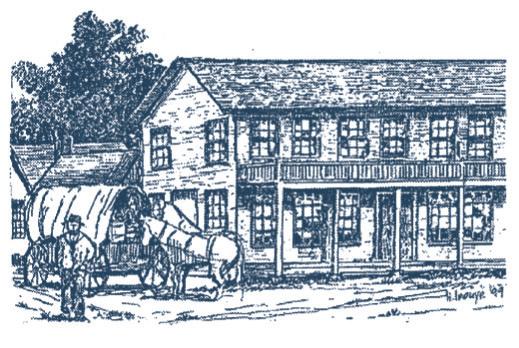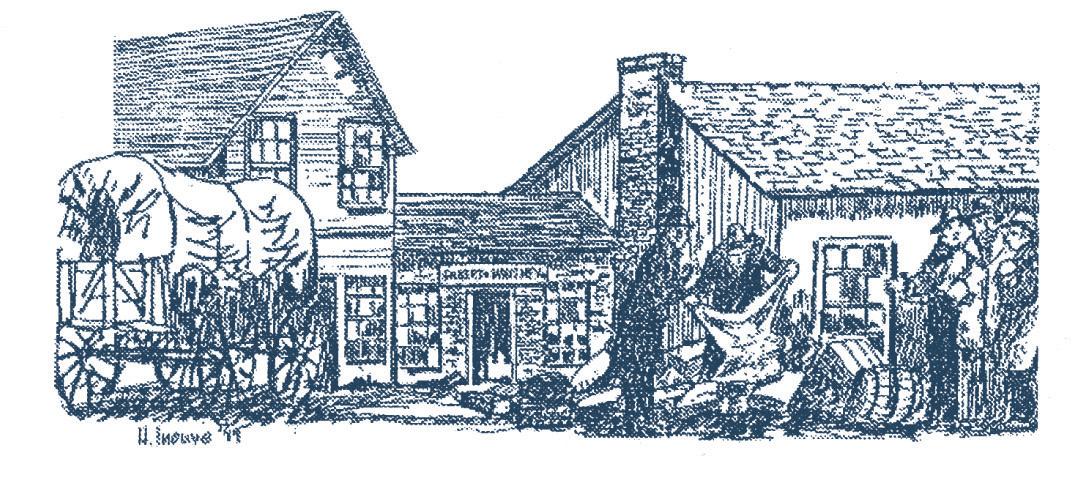Printing Off ice L ot 75
The first paper published in Independence, The Evening and the Morning Star, appeared from the Mormon press located on the west side of South Liberty Street in June 1832. W.W. Phelps, the church printer, and his family resided here. On July 20, 1833, locals demanded a halt to publication of the paper. After Phelps declined an ultimatum to the county, the press was thrown into the street. Large galley sheets of the church’s Book of Commandments were removed and placed in an old log stable behind the building. A. Sidney Gilbert’s nieces, Mary Elizabeth and Caroline, risked their lives to successfully rescue some of the galley sheets. A large tree trunk was forced through the lower windows of the printing office and used to wrench the brick building from its foundation. The roof was drawn into the street. The press was heavily damaged and the office rendered unusable.

For several days following the July 20, 1833 attack on the printing office, church members were hunted and abused. Other businesses of the church members and their private homes were substantially damaged. A compromise temporarily halted the violence, and church members agreed to move from the county by the following spring. The printing building was later repaired and occupied until about 1930.
10) Log Courthouse

Original Location, Lot 59
This building was constructed as Jackson County’s first courthouse in 1827 by enslaved labor. The county built a new brick courthouse on the Public Square in 1830. In February 1832, Mormon merchant A. Sidney Gilbert purchased the vacated building in the name of the firm of Gilbert and Whitney for $371. It served as the home of the extended Gilbert family including niece Mary Elizabeth Rollins. It was also the location of a church mercantile business and storehouse. In November 1832, Gilbert relocated the church store activities to the Square on Lot 51, but his family continued to reside in the former log courthouse. The structure was moved to its present Kansas Avenue location in 1916 for preservation purposes.

11) Boggs Home Lot 5
In 1831, County Clerk Lilburn W. Boggs’ home was located on the northwest corner of Maple and Lynn. Following the arrival of the Mormons, missionary Peter Whitmer, Jr. began working as a tailor offering the latest eastern fashions. Boggs furnished some space in his home for Whitmer’s tailoring trade. Alexander Doniphan, a Clay County lawyer of growing repute wrote, “Peter Whitmer was a tailor and I employed him to make me a suit of clothes.”

13) 1827 Jail Lot 2
The 1827 county jail was located at the back of the lot at the southeast corner of present-day Main and Truman. An outside stairway to the upper room was the only way to enter the hewn log structure

16 x 16 feet square. Prominent Mormons, A. Sidney Gilbert, William McLellin, John Corrill, and Isaac Morley, were jailed in the lower dungeon in November 1833. A decade later, Orrin Porter Rockwell was held in the second jail built on this site. The present building on this site was a city fire station and today serves as the Truman Home ticket office. When the two other cultures clashed again in the fall of 1833, armed conflict highlighted the violence. Church leaders in Independence were arrested following a battle between opposing sides in Christian Whitmer’s cornfield in Kaw Township. A party of Mormons, under the leadership of Lyman Wight, on their way to aid jailed church leaders were met by and surrendered to the local militia just west of town on present day Lexington.
By means of night raids and frightened violence, citizens, emboldened by disarming the Mormons, forced church members to flee the county for their lives. The largest group of disciples fled north and crossed the Missouri as quickly as possible. Survivors endured the remainder of the season huddled in makeshift shelters along the cottonwood bottoms in Clay County. The Mormon stay in Clay County spanned two years, while hope for a return to their Jackson County lands faded. A new sanctuary was found in 1836. Caldwell County, a special county just for the Mormons, was carved from northern Ray County. Forced into flight again, the church was expelled from the state following the 1838 “Mormon War.”
14) Boggs Home Lot 131
Missouri Mormon Walking Tour
Present Location, Kansas Avenue
12) Noland House Lot 10
A popular inn, the Noland House was located on the northwest corner of Main and Maple. In 1838 Joseph Smith and Mormon leaders were held in this hotel under house arrest while awaiting trial. Occasionally free to walk about the town, the prisoners visited the Temple Lot. Parley P. Pratt wrote, “When we saw it last it was a noble forest but our enemies had since robbed it of every vestige of timber, and it now lay desolate, or clothed with grass and weeds…While at Independence we were once or twice invited to dine with General Wilson and some others which we did.”

Lilburn W. Boggs lived in a small house facing south Spring Street in Independence following his term as Governor of the State of Missouri. While Governor, Boggs issued the infamous Extermination Order of 27 October 1838 that led to the expulsion of over 5,000 Mormons from the state of Missouri. Boggs’ home was also the site of the alleged assassination attempt by Orrin Porter Rockwell on May 6, 1842. Rockwell was later tried and acquitted. Many communities have gained valuable lessons from a difficult past. Today, Independence enjoys cultural diversity and cooperation between many groups and organizations.
15) National Frontier Trails Museum
As you complete the walking trail with site number 14, we suggest that you cross the tracks to the south and tour the National Frontier Trails Museum. Here you will see numerous exhibits about the trip west on the trails by emigrants, explorers, Mormons and business adventurers. An excellent film on the Mormon Battalion is available for viewing on request.
THE
MISSOURI MORMON FRONTIER FOUNDATION
P.O. Box 3186, Independence, Missouri 64055 www.mmff.net
Mormon walking trail is a joint project of the City of Independence, Missouri, and MMFF. MMFF is a nonsectarian, not-for-profit group dedicated to the promotion and understanding of local history.

Drawings ©1999 Henry K. Inouye Jr.
For more information contact the Independence Tourism Department (816)325-7890 • VisitIndependence.com
VISIT INDEPENDENCE, MISSOURI
8)
9) Log Courthouse
lilburn w. boggs
Joseph s mith, J r.
Missouri Mormon Wal king Trail
During the 1830s, Independence was a celebrated national garden spot on the western border of a rapidly expanding country. Beyond Independence stretched rich untouched prairie and half of an unexplored continent full of opportunity. The region’s abundant forests, streams and valleys seemed to attract folks from every walk of life to Jackson County, Missouri, slave and freeman, immigrant and entrepreneur, bullwhacker and missionary, southerner and Hispanic. Following its selection as county seat of Jackson County in 1827, Independence emerged as a tough frontier community of settlers and storekeepers. Local politics mainly reflected the interests of the region’s predominately southern population. Independence symbolized many different dreams for those it attracted. Southern settlers found cheap new land for homes and plantations. The new town was the perfect jumping-off point for exploitation of the great western wilderness. The area promised sanctuary for some from the long arm of the law. And to a religious body popularly known as “Mormons”, Independence represented the place they called “Zion.” Here they believed Christ would one day establish the Kingdom of God on Earth.
One cold day in late January 1831, five “Mormon” missionaries–Oliver Cowdery, Ziba Peterson, Parley P. Pratt, Peter Whitmer, Jr., and Frederick G. Williams–made their first appearance in town. They represented the new Church of Christ, popularly known as “Mormons,” recently organized in the state of New York on April 6, 1830. They were followers of a young religious prophet, Joseph Smith, Jr. Their northern manners and unusual interest in tribes of Native Americans gathering to the west of the Missouri state line immediately drew attention. Two of their number sought employment, where the remaining three continued on preaching to the nearby Shawnee and Delaware tribes. Revealed scripture, known as the Book of Mormon, viewed Native Americans as part of the lost tribes of Israel. Mormon missionaries seeking to share these understandings with tribes to the west quickly discovered they did not have the proper papers issued by the federal government since federal law forbade access to the Native Americans. Turning potential failure into alternative success, they proselytized among residents of Jackson and surrounding counties. Word of these inroads prompted Joseph Smith and additional converts to come from the east.

1 Temple Lot
Arriving in mid-summer 1831, church leader Joseph Smith, Jr., identified Independence as the church gathering place. A temple complex was envisioned as the center of a city to be called Zion. On August 3, 1831, part of Jones H. Flournoy’s farm was dedicated. This area is known as the Temple Lot. There was no progress on temple construction during the 1830s. Soon Mormon immigrants began gathering to Independence. Some made their homes in town, while others helped plant new church settlements around the surrounding county. The envisioned colony reflected the new religion’s largely northern heritage. Church administrative and social structures strove to harness the physical, spiritual, and economic potentials of the rapidly growing body to accomplish common goals. Business and economic cooperation were attempted to promote participants success. The rapid growth of the colony and fear of its triumph fostered concern among non-member observers. Many believed such apparent clannishness and devotion to be unnatural.
2 Flournoy Home Present Location, 1030 Block West Lexington
In 1826, the Jones H. Flournoy family lived in this small brick building. Negotiations for the Temple Lot are thought to have taken place in this building between Flournoy and Bishop Edward Partridge on behalf of the church. Flournoy transferred 63 acres of land to Partridge in December 1831. After Flournoy disposed of his lands, the Moses G. Wilson family resided in the house. In the 1860s, as part of a greatly expanded structure, this building was the home of Santa Fe trader William M. F. McGraw. John T. Smith purchased it in 1866 and constructed a large addition on the east facing Pleasant Street. In 1963 the First Christian Church needed the mansion space for parking. The original Flournoy house was rescued from demolition when William and Annette Curtis dismantled, moved, and reconstructed the building near their home. Relocated to its present site in 1989, this building is one of the few remaining examples of Independence pioneer home construction. Mormon social cohesiveness, coupled with competition over scarce resources such as land, proved a threat to rugged individualistic frontier values. Within a few short years, fears erupted into violence.
3)
Partridge Home Site and School
The homes of local church leaders Bishop Edward Partridge and Counselors John Corrill and Isaac Morley were located along the main trail leading from Independence toward the Unorganized Territory to the west. In 1833 Partridge was forcibly taken from his home and tarred and feathered on the Public Square. A brick school was also nearby and used as a meetinghouse during unpleasant weather. Near this location, Mormons surrendered their weapons to the Missouri Militia in November 1833.
4) Flournoy Home Original Location, Lot 92

In 1826, Jones Hoy Flournoy constructed a four-room south-facing brick home here along the western edge of the town of Independence for his family. When the Mormons selected Independence as their center of gathering in 1831, Bishop Edward Partridge negotiated with Flournoy for rights to a site for a temple. Friction between the Mormons and other settlers in Jackson County escalated, ending with the expulsion of church members from the county in November 1833. Similar problems followed the church into Clay and Caldwell counties in northern Missouri. Following their surrender and arrest at Far West, Missouri, November 1838, Joseph Smith and other leaders were returned to Independence as prisoners. By 1838, Moses G. Wilson and his wife Margaret Ann owned the Flournoy House and invited Joseph Smith to dine with them. General Wilson had taken a lead among citizens driving the Mormons out of Jackson County. In addition, the Wilsons had lost a son in the so-called “Mormon War.” During dinner, as Joseph recounted a stirring narration of what church members endured during their expulsions from Jackson County and northern Missouri, Margaret Ann Wilson was so moved that tears ran down her face.
The Public Square surrounding the courthouse was the focus of escalating tension among the Mormons and other Missouri settlers. Sidney Rigdon, a noted church leader, preached from the courthouse steps in 1832. Later, church members Edward Partridge and Charles Allen were tarred and feathered on the square, July 20, 1833. In November, Mormon leaders were arrested and subsequently appeared in the courtroom. While surrendering to the local Militia, church members stacked their weapons around a large stump in the courthouse yard.
Among the earliest Mormons in Independence, Robert and Hannah Rathbun owned this lot. Their blacksmith shop was broken into July 20, 1833. Along with other church members, the Rathbuns were eventually forced to leave the county.


The northwest corner of Liberty and Lexington is the site of the Gilbert and Whitney & Co. church store, purchased in November 1832 by A. Sidney Gilbert. In 1833, 500 men gathered to demolish the establishment. Gilbert agreed to close the store. In November 1833, the business was again targeted for destruction, its doors battered open and contents strewn into the street. During the exodus of the Mormons from Jackson County, Gilbert and his family fled to Clay County, where he died of cholera in 1834.
 5) Rathbun Lot 43
6 Public Square
7 ) Gilbert and Whitney Store Lot 51
5) Rathbun Lot 43
6 Public Square
7 ) Gilbert and Whitney Store Lot 51
LEXINGTON 2 1 3 4 5 7 8 9 10 11 12 14 15 13 6 MAPLE MAPLE WHITE OAK PACIFIC PLEASANT SPRING OSAGE LIBERTY MAIN RIVER BOWEN UNION LEXINGTON ELM DELAWARE KANSAS WALNUT WALNUT TRUMAN RD TRUMAN RD NOLAND RD NOLAND RD
edward partridge












 5) Rathbun Lot 43
6 Public Square
7 ) Gilbert and Whitney Store Lot 51
5) Rathbun Lot 43
6 Public Square
7 ) Gilbert and Whitney Store Lot 51